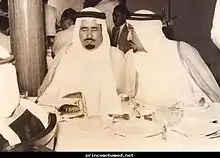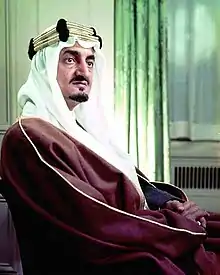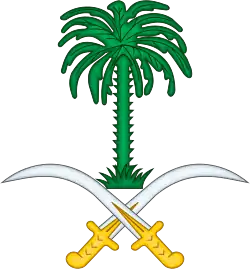Muhammad bin Abdulaziz Al Saud
Muhammad bin Abdulaziz Al Saud (4 March 1910 – 25 November 1988) (Arabic: محمد بن عبدالعزيز أل سعود Muḥammad bin 'Abd al-'Azīz Āl Sa'ūd) was one of the wealthiest and most powerful members of the House of Saud and briefly crown prince of Saudi Arabia between 1964 and 1965. His advice was sought and deferred to in all matters by his brothers. Until his death in 1988, he was a close and powerful confidant and senior adviser to his brothers, King Khalid (r. 1975–1982) and King Fahd (r. 1982–2005).[1]
| Muhammad bin Abdulaziz Al Saud | |||||
|---|---|---|---|---|---|
 Muhammad bin Abdulaziz Al Saud with his cousin, Mohammed bin Saud Al Kabir | |||||
| Crown Prince of Saudi Arabia | |||||
| Tenure | 2 November 1964 – 29 March 1965 | ||||
| Predecessor | Faisal | ||||
| Successor | Khalid | ||||
| Monarch | King Faisal | ||||
| Governor of Al Madinah Province | |||||
| Tenure | December 1925–1954 | ||||
| Monarch | Ibn Saud King Saud King Faisal | ||||
| Born | 4 March 1910 Riyadh, Emirate of Nejd and Hasa | ||||
| Died | 25 November 1988 (aged 78) Riyadh, Saudi Arabia | ||||
| Burial | 25 November 1988 Al Oud cemetery, Riyadh | ||||
| Issue | Prince Fahd Prince Abdul Rahman Prince Bandar Prince Badr Prince Sa'ad Prince Abdullah Prince Abdulaziz | ||||
| |||||
| House | House of Saud | ||||
| Father | Ibn Saud | ||||
| Mother | Al Jawhara bint Musaed Al Jiluwi | ||||
Early life

Prince Muhammad was the fourth son of Ibn Saud[2] in Qasr Al Hukm, Riyadh.[3] His birth date is, according to different sources, either 1909[4] or 1910.[5][6] Indeed, William A. Eddy also states that he was the third son (not fourth son) of Ibn Saud.[7]
Prince Muhammad's mother was Al Jawhara bint Musaed Al Jiluwi.[8][9] She was born into the important Al Jiluwis family,[10][11] which was in fact a cadet branch of the Al Saud family itself. She was a second cousin of her husband (their paternal grandfathers had been brothers). This was in keeping with long-standing traditions in Arabia of marriage within the same lineage, and members of the Al Jiluwi family frequently intermarried with the members of Al Saud family.[12]
Prince Mohammad was one of three children born to Al Jawhara bint Musaed and Ibn Saud. King Khalid was his full brother,[5] and he had a full sister, Al Anoud, who married successively two sons of Saad bin Abdul Rahman. Al Anoud was first given in marriage to Saud bin Saad. After Saud died, she was married to his brother Fahd bin Saad.[13]
Royal duties
From early age Prince Muhammad participated in fights during the formation years of the Kingdom with his older brothers and cousins. He and Prince Faisal were given the responsibility for the Ikhwan in mid-1920s.[14][15] In December 1925 Prince Muhammad was named governor of Madinah following the conquest of the city in which he also involved.[16][17] His tenure lasted until 1954.[6]
In 1934 Ibn Saud ordered his forces to attack Yemen's forward defences.[18] Then, Faisal bin Saad, the son of the Saudi king's brother Saad, advanced to Baqem and the son of his other brother Muhammad, Khaled bin Muhammad, advanced to Najran and Saada. King's son Prince Faisal assumed command of the forces on the coast of Tihama and Mohammed bin Abdulaziz had advanced from Najd at the head of a reserve force to support his brother Saud.[18]


Prince Muhammad together with then Crown Prince Saud represented Ibn Saud at the coronation of King George VI and Queen Elizabeth in London in 1937.[19][20] Prince Muhammad and Prince Mansour accompanied Ibn Saud in the latter's meeting with the then US president Franklin D. Roosevelt on 14 February 1945.[7][21] They together with their uncle Prince Abdullah also attended the meeting between Ibn Saud and British premier Winston Churchill in Egypt in February 1945.[22] Prince Muhammad also accompanied King Saud during his visit to the US in January 1962.[23]
Prince Muhammad was known as king-maker.[1][24] He was a key prince in the coalition against King Saud.[25] He was head of royal family council and acted as a mediator during the dispute between King Saud and Crown Prince Faisal.[26] He was sent to King Saud's Al Naṣariah Palace in Fall 1964 to demand his and his sons' loyalty to the chosen king, Faisal.[26] On 28 November 1964 Radio Mecca announced the allegiance of eleven of Saud's sons to King Faisal.[26] During the reign of King Khalid he was one of the members of the inner family council headed by the King and included his brothers Crown Prince Fahd, Prince Abdullah, Prince Sultan, and Prince Abdul Muhsin as well as two of his surviving uncles, Prince Ahmed and Prince Musaid.[27] Prince Muhammad was very influential in reducing the power of the Sudairi Seven, who attempted to put to end Prince Abdullah's potential position of future crown prince.[28] After the death of King Khalid on 13 June 1982, the royal family council led by Prince Muhammad expressed its allegiance to the new king, Fahd.[29]
Renunciation of the succession

Muhammad bin Abdulaziz was Crown Prince during the first few months (November 1964 – March 1965) of the reign of King Faisal. He then voluntarily stepped aside from the succession to allow his younger and only full brother, Prince Khalid, to become heir apparent to the Saudi throne.[1] Prince Muhammad's nickname was Abu Sharayn or "the father of two evils" (bad temper and drinking). In fact, his original nickname was "the father of evil" due to his aggressive and violent character during his youth which was first said by Ibn Saud.[20] In addition, Prince Muhammad was a frequent visitor to the parties in Beirut which he himself did not consider a proper act for a royal.[15] All such traits were the reasons for not being selected as the king by his brothers.[30][31]
It is also argued that Prince Muhammad, the oldest surviving son of Ibn Saud after Faisal, either declined the role of crown prince or was passed over because of his close association with King Saud during the latter's reign.[32]
Controversy
Prince Muhammad's granddaughter, Misha'al bint Fahd, was convicted of adultery in Saudi Arabia; she and her lover were sentenced to death on the explicit instructions of her grandfather, Prince Muhammad, who was a senior member of the royal family, for the alleged dishonour she brought on her clan and defying a royal order calling for her to marry a man selected by the family, and were subject to public execution. Western media criticized the event as a violation of women's rights. A British TV channel presented a dramatized documentary, Death of a Princess, which was based on this incident. The broadcast hurt Saudi–UK relations significantly.[33]
Following the execution, segregation of women became more severe,[34] and the religious police also began patrolling bazaars, shopping malls and any other place where men and women might happen to meet.[35] When Prince Muhammad was later asked if the two deaths were necessary, he said, "It was enough for me that they were in the same room together".[35]
Wealth
Prince Muhammad had considerable wealth which was based on his share of the sales of crude oil.[36] In the early 1980s his daily share was half a million barrel of oil.[36]
Views
Prince Muhammad objected to Prince Saud bin Abdulaziz's role as Crown Prince immediately after his installation to the post.[37] Prince Muhammad sent a letter to his father, King Abdulaziz, stating his negative views about Prince Saud's capacity to rule the state.[37]
Following the announcement that Prince Khalid was chosen as Crown Prince on 29 March 1965 Radio Mecca reported a statement by Prince Muhammad: "I would rather stay away from positions and titles."[38] Prince Muhammad later stated that he would not be a good king if he would have been chosen as the king.[15]
Prince Muhammad led the conservative members of the royal family.[39] They did not support the fast modernization of the society witnessed at the end of the 1970s and thought that modernization and the presence of too many foreign workers in the country would lead to the erosion of traditional Muslim values.[39][40]
Personal life and death
Muhammad bin Abdulaziz married five times to women linked to the Al Saud family.[20] He also had concubines.[20] He had twenty-nine children, seventeen sons and twelve daughters.[20] One of his daughters, Al Anoud bint Muhammed, was the spouse of Khalid bin Saud.[41]
Prince Fahd, the eldest son of Prince Muhammad, was one of the members of Al Saud Family Council established by Crown Prince Abdullah in June 2000 to discuss private issues such as business activities of princes and marriages of princess to individuals who were not member of House of Saud.[33] One of his grandsons, Muhammad bin Abdulaziz bin Muhammad, was named deputy governor of Jizan Province in May 2017.[42]
Prince Muhammad died at approximately 78 years of age[43] and was buried in Riyadh on 25 November 1988.[1][4]
Legacy
Prince Mohammad bin Abdulaziz Airport is named after him. A hospital in Riyadh, Prince Mohammed bin Abdulaziz Hospital, is also named after him.[44] In 2014 Saudi Ministry of Health started a medical complex in Sakakah, Al Jawf region, which is named after him, Prince Mohammad bin Abdulaziz Medical City.[45]
Ancestry
| Ancestors of Muhammad bin Abdulaziz Al Saud | |||||||||||||||||||||||||||||||||||||||||||||||||||||||||||||||||||||||||||||||||||||||||||||||||||||||||||||||||||||||||||||||||||||||||||||||||||||||||||||||||||||||||||||||||||||||||||||||||||||||||||||||||||||||||||||||||||||||||||||||||||||||||||||||||||||||||||||||||||||||||||||||||||||||||||||||||||||||||||||||||||||||||||||||||||||||||||||||||||||||||||||||||||||||||||||||||||||||||||||||||||||||||||||||||||||||||||||||||||||||||||||||||||||||||||||||||||||||||||||||||||||||||||||||||||||||||||||||||||||||||||||||||||||||||||||||||||||||||||||||||||||||||||||||||||||||||||||||||||||||||||||||||||||||||||||||||||||||||||||||||||||||||||||||||||||||||||||||||||||||||||||||||||||||||||||||||||||||||||||||||||||||||||||||||||||||||||||||||||||||||||||||||||||||||||||||||||||||||||||||||||||||||||||||||||||||||||||||||||||||||||||||||||||||||||||||||||||||||||||||||||||||||||||||||||||||||||||||||||||||||||||||||||||||||||||||||||||||||||||||||||||||||||||||||||||||||||||||||||||||
|---|---|---|---|---|---|---|---|---|---|---|---|---|---|---|---|---|---|---|---|---|---|---|---|---|---|---|---|---|---|---|---|---|---|---|---|---|---|---|---|---|---|---|---|---|---|---|---|---|---|---|---|---|---|---|---|---|---|---|---|---|---|---|---|---|---|---|---|---|---|---|---|---|---|---|---|---|---|---|---|---|---|---|---|---|---|---|---|---|---|---|---|---|---|---|---|---|---|---|---|---|---|---|---|---|---|---|---|---|---|---|---|---|---|---|---|---|---|---|---|---|---|---|---|---|---|---|---|---|---|---|---|---|---|---|---|---|---|---|---|---|---|---|---|---|---|---|---|---|---|---|---|---|---|---|---|---|---|---|---|---|---|---|---|---|---|---|---|---|---|---|---|---|---|---|---|---|---|---|---|---|---|---|---|---|---|---|---|---|---|---|---|---|---|---|---|---|---|---|---|---|---|---|---|---|---|---|---|---|---|---|---|---|---|---|---|---|---|---|---|---|---|---|---|---|---|---|---|---|---|---|---|---|---|---|---|---|---|---|---|---|---|---|---|---|---|---|---|---|---|---|---|---|---|---|---|---|---|---|---|---|---|---|---|---|---|---|---|---|---|---|---|---|---|---|---|---|---|---|---|---|---|---|---|---|---|---|---|---|---|---|---|---|---|---|---|---|---|---|---|---|---|---|---|---|---|---|---|---|---|---|---|---|---|---|---|---|---|---|---|---|---|---|---|---|---|---|---|---|---|---|---|---|---|---|---|---|---|---|---|---|---|---|---|---|---|---|---|---|---|---|---|---|---|---|---|---|---|---|---|---|---|---|---|---|---|---|---|---|---|---|---|---|---|---|---|---|---|---|---|---|---|---|---|---|---|---|---|---|---|---|---|---|---|---|---|---|---|---|---|---|---|---|---|---|---|---|---|---|---|---|---|---|---|---|---|---|---|---|---|---|---|---|---|---|---|---|---|---|---|---|---|---|---|---|---|---|---|---|---|---|---|---|---|---|---|---|---|---|---|---|---|---|---|---|---|---|---|---|---|---|---|---|---|---|---|---|---|---|---|---|---|---|---|---|---|---|---|---|---|---|---|---|---|---|---|---|---|---|---|---|---|---|---|---|---|---|---|---|---|---|---|---|---|---|---|---|---|---|---|---|---|---|---|---|---|---|---|---|---|---|---|---|---|---|---|---|---|---|---|---|---|---|---|---|---|---|---|---|---|---|---|---|---|---|---|---|---|---|---|---|---|---|---|---|---|---|---|---|---|---|---|---|---|---|---|---|---|---|---|---|---|---|---|---|---|---|---|---|---|---|---|---|---|---|---|---|---|---|---|---|---|---|---|---|---|---|---|---|---|---|---|---|---|---|---|---|---|---|---|---|---|---|---|---|---|---|---|---|---|---|---|---|---|---|---|---|---|---|---|---|---|---|---|---|---|---|---|---|---|---|---|---|---|---|---|---|---|---|---|---|---|---|---|---|---|---|---|---|---|---|---|---|---|---|---|---|---|---|---|---|---|---|---|---|---|---|---|---|---|---|---|---|---|---|---|---|---|---|---|---|---|---|---|---|---|---|---|---|---|---|---|---|---|---|---|---|---|---|---|---|---|---|---|---|---|---|---|---|---|---|---|---|---|---|---|---|---|---|---|---|---|---|---|---|---|---|---|---|---|---|---|---|---|---|---|---|---|---|---|---|---|---|---|---|---|---|---|---|---|---|---|---|---|---|---|---|---|---|---|---|---|---|---|---|---|---|---|---|---|---|---|---|---|---|---|---|---|---|---|---|---|---|---|---|---|---|---|---|---|---|---|---|---|---|---|---|---|---|---|---|---|---|---|---|---|---|---|---|---|---|---|---|---|---|---|---|---|---|---|---|---|---|---|---|---|---|---|---|---|---|---|---|---|---|---|---|---|---|---|---|---|---|---|---|---|---|---|---|---|---|---|---|---|---|---|---|---|---|---|---|---|---|---|---|---|---|---|---|---|---|---|---|---|---|---|---|---|---|---|---|---|---|---|---|---|---|---|---|---|---|---|---|---|---|---|---|---|---|---|---|---|---|---|---|---|---|---|---|---|---|---|---|---|---|---|---|---|---|---|---|---|---|---|---|---|---|---|---|---|---|---|---|---|---|---|---|---|---|---|---|---|---|---|---|---|---|---|---|---|---|---|---|---|---|---|---|---|---|---|---|---|---|---|---|---|---|---|---|---|---|---|---|---|---|---|---|---|---|---|---|---|---|---|---|---|---|---|---|---|
| |||||||||||||||||||||||||||||||||||||||||||||||||||||||||||||||||||||||||||||||||||||||||||||||||||||||||||||||||||||||||||||||||||||||||||||||||||||||||||||||||||||||||||||||||||||||||||||||||||||||||||||||||||||||||||||||||||||||||||||||||||||||||||||||||||||||||||||||||||||||||||||||||||||||||||||||||||||||||||||||||||||||||||||||||||||||||||||||||||||||||||||||||||||||||||||||||||||||||||||||||||||||||||||||||||||||||||||||||||||||||||||||||||||||||||||||||||||||||||||||||||||||||||||||||||||||||||||||||||||||||||||||||||||||||||||||||||||||||||||||||||||||||||||||||||||||||||||||||||||||||||||||||||||||||||||||||||||||||||||||||||||||||||||||||||||||||||||||||||||||||||||||||||||||||||||||||||||||||||||||||||||||||||||||||||||||||||||||||||||||||||||||||||||||||||||||||||||||||||||||||||||||||||||||||||||||||||||||||||||||||||||||||||||||||||||||||||||||||||||||||||||||||||||||||||||||||||||||||||||||||||||||||||||||||||||||||||||||||||||||||||||||||||||||||||||||||||||||||||||||
References
- "Prince Mohammed of Saudi Arabia". The Palm Beach Post. AP. 26 November 1988. Retrieved 5 August 2012.
- Nabil Mouline (April–June 2012). "Power and generational transition in Saudi Arabia" (PDF). Critique Internationale. 46: 1–22.
- ""قصر الحكم" يحتفظ بأجمل الذكريات لأفراد الأسرة ... - جريدة الرياض". Al Riyadh (in Arabic). 23 May 2007. Retrieved 26 October 2020.
- "Reigning Royal Families". World Who's Who. Retrieved 4 March 2013.
- Winberg Chai (22 September 2005). Saudi Arabia: A Modern Reader. University Press. p. 193. ISBN 978-0-88093-859-4.
- Susan Rose (25 November 2020). The Naval Miscellany: Volume VI. Taylor & Francis. p. 433. ISBN 978-1-00-034082-2.
- William A. Eddy (2005). FDR meets Ibn Saud (PDF). Vista: Selwa Press.
- "Personal trips". King Khalid Exhibition. Archived from the original on 22 October 2012. Retrieved 7 May 2012.
- "Al Saud Family (Saudi Arabia)". European Institute for Research on Euro-Arab Cooperation. Archived from the original on 8 March 2016. Retrieved 29 April 2012.
- Helen Chapin Metz (1992). "Saudi Arabia: A Country Study". Retrieved 9 May 2012.
- "The New Succession Law Preserves The Monarchy While Reducing The King's Prerogatives". Wikileaks. 22 November 2006. Archived from the original on 19 November 2013. Retrieved 2 April 2013.
- Joshua Teitelbaum (1 November 2011). "Saudi Succession and Stability" (PDF). BESA Center Perspectives. Retrieved 24 April 2012.
- "Family Tree of Al Anud bint Abdulaziz bin Abdul Rahman Al Saud". Datarabia. Retrieved 10 August 2012.
- Jennifer Reed (1 January 2009). The Saudi Royal Family. Infobase Publishing. p. 40. ISBN 978-1-4381-0476-8.
- Ellen R. Wald (3 April 2018). Saudi, Inc. Pegasus Books. p. 185. ISBN 978-1-68177-718-4.
- Mohammad Zaid Al Kahtani (October 2004). "The foreign policy of King Abdulaziz (1927-1953): A study in the international relations of an emerging state" (PDF). University of Leeds. Retrieved 20 September 2020.
- Talal Sha'yfan Muslat Al Azma (1999). "The role of the Ikhwan under 'Abdul'Aziz Al Sa'ud 1916-1934" (PhD Thesis). Durham University. p. 170. Retrieved 4 September 2020.
- Yunan Labib Rizk (2004). "Monarchs in war". Al Ahram Weekly. Archived from the original on 28 February 2012. Retrieved 23 April 2012.
- "Saudi Foreign Policy". Saudi Embassy Magazine. Fall 2001. Archived from the original on 7 August 2013. Retrieved 18 July 2013.
- Jafar Al Bakl (16 December 2014). "الفحولة وآل سعود... والشرف المراق على جوانبه الدم". Al Akhbar (in Arabic). Retrieved 12 September 2020.
- Thomas W. Lippman (April–May 2005). "The Day FDR Met Saudi Arabia's Ibn Saud" (PDF). The Link. 38 (2): 1–12.
- "Riyadh. The capital of monotheism" (PDF). Business and Finance Group. Archived from the original (PDF) on 14 October 2009. Retrieved 22 July 2013.
- Charles Ralls (25 January 1962). "King Saud arrives here for convelescence stay". Palm Beach Daily News. Retrieved 9 February 2013.
- Stig Stenslie (Summer 2016). "Salman's Succession: Challenges to Stability in Saudi Arabia". The Washington Quarterly. 39 (3): 117–138. doi:10.1080/0163660X.2016.1204413. S2CID 156097022.
- William Quandt (1981). Saudi Arabia in the 1980s: Foreign Policy, Security, and Oil. Washington DC: The Brookings Institution. p. 79. ISBN 0815720513.
- Joseph Mann (2013). "King without a Kingdom: Deposed King Saud and his intrigues". Studia Orientalia Electronica. 1.
- Gulshan Dhahani (1980). "Political Institutions in Saudi Arabia". International Studies. 19 (1): 59–69.
- Abdullah Hazaa Othman; Oleg E. Grishin; Bakil Hassan Nasser Ali (2020). "The Conflict Wings in the Saudi Political System". Journal of Politics and Law. 13 (3).
- "Crown Prince Fahd takes control of largest oil-exporting nation". Herald Journal. 14 June 1982. Retrieved 28 July 2012.
- Michael Herb (1999). All in the family. Albany: State University of New York Press. p. 102. ISBN 0-7914-4168-7.
- As'ad AbuKhalil (2004). The Battle for Saudi Arabia. Royalty, fundamentalism and global power. New York City: Seven Stories Press. ISBN 1-58322-610-9.
- A. R. Kelidar (1978). "The problem of succession in Saudi Arabia". Asian Affairs. 9 (1): 23–30. doi:10.1080/03068377808729875.
- Simon Henderson (August 2009). "After King Abdullah: Succession in Saudi Arabia". The Washington Institute. Retrieved 27 May 2012.
- "King Fahd". Telegraph.
- Mark Weston (28 July 2008). Prophets and Princes: Saudi Arabia from Muhammad to the Present. John Wiley & Sons. ISBN 9780470182574 – via Google Books.
- Peter W. Wilson; Douglas F. Graham (16 September 2016). Saudi Arabia: The Coming Storm. Taylor & Francis. p. 32. ISBN 978-1-315-28699-0.
- "عورات آل سعود المستورة "ج4" (الانقلاب الأول)". Sasa Post (in Arabic). 30 May 2015. Retrieved 3 October 2020.
- Mohamed Zayyan Aljazairi (1968). "Diplomatic history of Saudi Arabia, 1903-1960's" (MA Thesis). The University of Arizona. p. 53. Retrieved 18 September 2020.
- Andrew J. Pierre (Summer 1978). "Beyond the "Plane Package": Arms and Politics in the Middle East". International Security. 3 (1): 148–161. doi:10.2307/2626647. JSTOR 2626647.
- Lincoln P. Bloomfield Jr. (1981). "Saudi Arabia Faces the 1980s: Saudi Security Problems and American Interests". Fletcher Forum.
- "أبرزهن شمس البارودي وسهير رمزي.. 5 زيجات للأمير خالد بن سعود". Al Wafd (in Arabic). 7 July 2020. Retrieved 14 September 2020.
- John Duke Anthony (3 May 2017). "How the World Turns: Saudi Arabia in Transition". National Council on US-Arab Relations. Retrieved 7 July 2020.
- Simon Henderson (1994). "After King Fahd" (Policy Paper). Washington Institute. Retrieved 2 February 2013.
- "Prince Mohammed bin Abdulaziz Hospital website". Prince Mohammed bin Abdulaziz Hospital. Retrieved 19 June 2020.
- "Prince Mohammad bin Abdulaziz Medical City (PMMC)". MENA report. London. 11 February 2014. ProQuest 1497076165. Retrieved 6 September 2020.
External links
| Saudi Arabian royalty | ||
|---|---|---|
| Preceded by Faisal |
Crown Prince of Saudi Arabia 2 November 1964 – 29 March 1965 |
Succeeded by Khalid |


